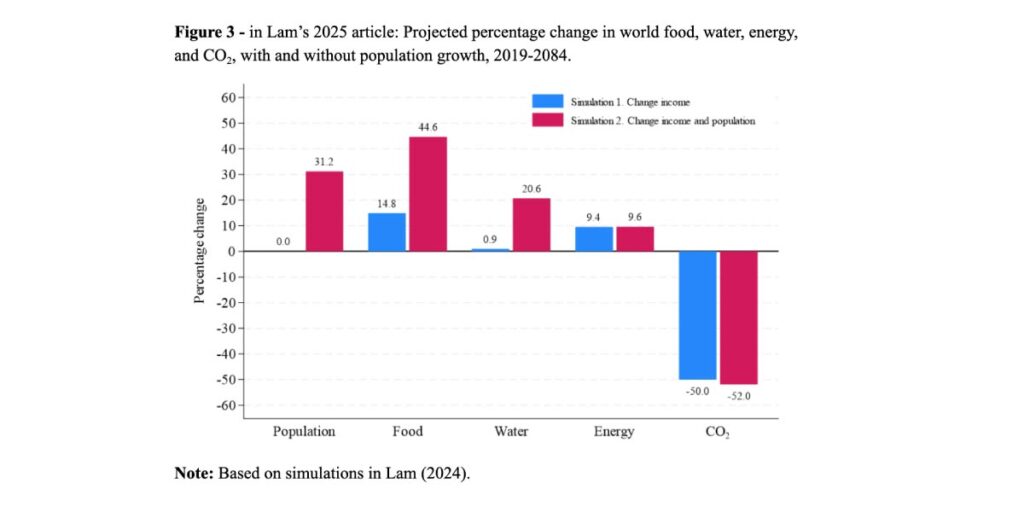Richard Grossman joins the ongoing N-IUSSP debate on the sustainability of current and predicted population growth. He takes up several of the arguments that make David Lam moderately optimistic about the future, and throws doubt on each of them: the reasons for concern are more numerous than Lam’s article suggests.
Recently, David Lam wrote a N-IUSSP essay “How will two billion more people affect food, water, energy, and CO2?” (Lam 2025). It is based on recent research and summarizes two of his papers. I am concerned that, although based on our current understanding of the past and contemporary projections for the future, Lam’s predictions are too optimistic.
In this paper Lam looks at four resources: food, water, energy and CO2. The paper projects human population growth and fertility over the next six decades, using the UN (2024) database. These data predict that the richer parts of the world will have constant or decreasing populations, while population growth will mainly occur in the poorer countries. There is no surprise here.
A startling prediction
Lam’s surprising outcome of these projections is that global energy usage will only increase about 9 percent, and that global CO2 production will decrease by more than 50 percent. (See Figure 3 in his article, reproduced below). Neither of these figures is affected significantly by population growth.

In addition to CO2 and energy, Lam looks at food production and water. As would be expected, demand for both of these resources increases with increasing human population, for food more so than water.
Reasons for concern
I have several concerns about the claims of this paper. The first relates to sustainability. The Ecological Footprint currently estimates that we are using the planet’s resources at a rate that is 1.75 times what would be sustainable. Any further increase in population is likely to increase earth’s overshoot. Secondly, the estimates of future usage of resources are based on current availability, which is likely to change. For instance, in many locations the water table is dropping – in some places, at a very rapid rate. Topsoil is also decreasing, which will also limit food production. Furthermore, what topsoil is left is being poisoned in many places by agricultural chemicals that are reducing fertility – both of crops and, perhaps, of humans.
Many biologists feel that we are entering the sixth mass extinction. They estimate that the human enterprise is causing loss of species at a thousand times the normal rate (Ceballos et al 2015). It is impossible to predict how this will upset the balance of nature and thus affect our species, but many fear that the outcomes of these extinctions will be detrimental and perhaps even disastrous.
The effects of climate chaos can only be guessed. However, it is very likely that the net effect will be disadvantageous to humans. Southwestern North America is already experiencing a megadrought that seems to be at least partially caused by anthropogenic climate heating (Park et al. 2020). Drought reduces food production, and similarly is likely to decrease hydroelectric power generation.
Politicians, who have control over so much of the world’s people and resources, are unpredictable. One person, in a position of high authority, can ruin the plans and predictions of more forward-thinking people. An example is the current US administration that is denying climate chaos and removing support for steps that would improve humans’ approach to sustainability.
For his modeling, Lam chose IPCC scenario SSP2-4.5, the “middle of the road” projection of fossil fuel emissions. This predicts decreased carbon emissions, especially in higher-income countries. Unfortunately, recent elections in several high-income countries make this scenario less likely.
Finally, UN (2024) population forecasts, upon which Lam has based his predictions, tend to underestimate the rate of growth (O’Sullivan 2023). Even without this confounding error, projections of human population tend to be especially unreliable for periods longer than 5 decades, and Lam’s predictions are for a 65-year time span.
A welcome note of optimism, despite all
Despite all these concerns, I hope that David Lam is correct! Unfortunately (or perhaps mercifully), neither of us will live to find out how valid the predictions are. In any case, the article is a welcome change from the pessimism that I often feel from reading doomful news in the media.
References
Ceballos G, Ehrlich PR, Barnosky AD, García A, Pringle RM, Palmer TM. (2015) Accelerated modern human-induced species losses: Entering the sixth mass extinction. Sci Adv. Jun 19;1(5):e1400253. doi: 10.1126/sciadv.1400253. PMID: 26601195; PMCID: PMC4640606.
Lam, D (2025). How will two billion more people affect food, water, energy and CO2. NIUSSP January 20, 2025.
Lam, David (2024). The Next 2 Billion: Can the World Support 10 Billion People? Population and Development Review. https://doi.org/10.1111/padr.12685.
O’Sullivan, JN. 2023. Demographic Delusions: World Population Growth is Exceeding Most Projections and Jeopardising Scenarios for Sustainable Futures. World, 4, 545-568. https://doi.org/10.3390/world4030034
Park Williams, A et al. (2020) Large contribution from anthropogenic warming to an emerging North American megadrought. Science 368, 314-318. DOI:10.1126/science.aaz9600
United Nations (2024). World Population Prospects 2024. United Nations Department of Economic and Social Affairs, Population Division.


